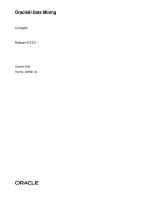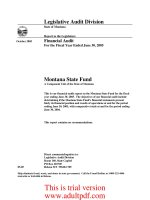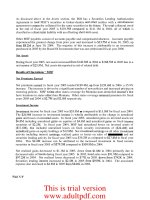PMP errata october
Bạn đang xem bản rút gọn của tài liệu. Xem và tải ngay bản đầy đủ của tài liệu tại đây (89.46 KB, 4 trang )
PMP Course Errata
Date
10/5/18
Question ID
N/A
Module
7
Lesson
Control Quality
Update or Errata
The department metric for answering calls is
that a person, not a machine, answers 95%
of all calls within
three minutes. The ACD system can print
out reports for any day that shows the
volume of calls and the
average hold time. According to the report,
the average hold time is 152 seconds.
So that Karen didn't need to look at the data
for the past year, she used statistical
sampling to select 24
random days in the past year. She decided
to put the data on a control chart (see
below). A control chart is a
graphic display of process data over time
and against established control limits, and
has a centerline that
assists in detecting a trend of plotted values
toward either control limit.
For Karen, showing the control limits didn't
make sense, because the process is clearly
out of control. Instead,
she decided to show the upper specification
limit (180 seconds) and the average hold
time (152 seconds). The
figure below, plotting the run chart with the
average hold times against the upper
specification limit (that is,
PMP Course Errata
the metric), illustrates that the average hold
time was significantly greater than the
metric
The department metric for answering
calls is that a person, not a machine,
answers 95% of all calls within one
minute. The ACD system can print out
reports for any day that shows the
volume of calls and the average hold
time. According to the report, the
average hold time is 60 seconds.
So that Karen wouldn’t need to look at
the data for the past year, she used
statistical sampling to select 24 random
days in the past year. She decided to put
the data on a control chart (see below). A
control chart is a graphic display of
process data over time and against
established control limits, and has a
centerline that assists in detecting a
trend of plotted values toward either
control limit.
Instead of showing a statistically
calculated control limit, Karen decided to
show upper specification limit (90
seconds) and the average hold time (60
seconds). The
PMP Course Errata
figure below, plots the run chart with the
average hold times against the upper
specification limit. This illustrates that
while the average hold time was aligned
with the metric, there are times of the
day where the results are over the upper
specification limit.
Specifically, from 8 a.m. to 10:59 a.m., the
average hold time was greater than the
upper specification; from 1
p.m. to 1:59 p.m., hold times were greater
than the upper specification as well. The
fluctuation in the sample
data shows common-cause variation. In
other words, you would expect the average
hold time to vary because
of the variables in the process (people, time
of day, amount of training). If Karen noted
any irregularities, she
would look for a special cause, such as
someone being out sick, a software upgrade
installation, a holiday, or
some other unusual event
Specifically, from 9 a.m. to 2 p.m., the
average hold time was greater than the
upper specification. The fluctuation in
the sample data shows common-cause
variation. In other words, you would
PMP Course Errata
expect the average hold time to vary
because of the variables in the process
(people, time of day, amount of training).
If Karen noted any irregularities, she
would look for a special cause, such as
someone being out sick, a software
upgrade installation, a holiday, or some
other unusual event.
10/5/18
N/A
14
Critical Path Calculations
3. Using the Late Start date, subtract 1 to derive the
Late Finish date for any immediately preceding
activities. The running example has two final activities:
Activity I and Activity F. Use the higher number as the
Late Finish date. Activity I finishes on Day 22, and
Activity F finishes on Day 13. Therefore, the Late Finish
for the project is Day 22. For Activity I, you subtract
the duration of 4, add 1, and get a Late Start of 19. Day
19 is the latest date when Activity I can start and not
cause the project to be late.
10/22/18
10/22/18
DSP3-LQ-001
ECPM2-TB-002_18
5
6
Develop Schedule Part 3
Estimated Costs Part 2
Correct answer is fast-track.
Rationale for question should read, “Correct.
Your contingency reserve is within the control of
the project manager and is used for project
risks.” The word “unforeseen” has been
removed.









